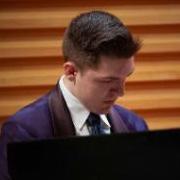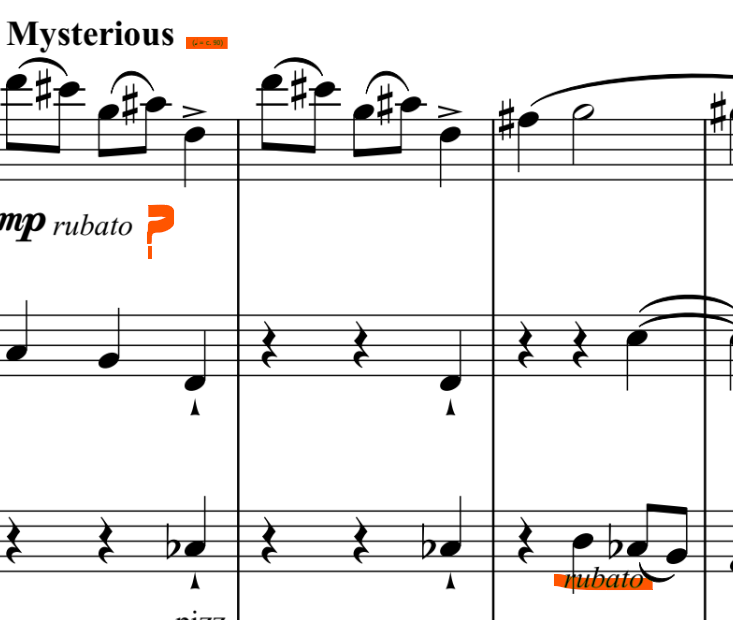Leaderboard
Popular Content
Showing content with the highest reputation since 12/02/2024 in all areas
-
So this is the final draft of the entire 2nd movement of my String Sextet. I can confidently say this is my best movement of music ever written up to date. The movement is divided into three parts: Lamentoso, Fugue a6 and the Return. The first two parts of the movements have been posted before in below links: Lamentoso: Fugue a6: If you want to skip to the newest content I compose, you may skip to 20:16. The musical analysis of the Lamentoso and Fugue have already been done in the link posted above so I won’t repeat it here. Here is the YT link and score of the movement: (Final Draft) String Sextet 2nd mov with last page.pdf Here is the YC post to the first mov of the same Sextet: Here is the structure of the movement: 00:00 Lamentoso The Eden in the 1st mov is great but man, come on and live in the real world. All sorts of tragedies happening and what ground do you have to claim the transcendence? I especially love the outburst in 4:59 and the passage starts from 8:53. 11:47 Fugue a6. This part is totally inspired by Vince’s @Thatguy v2.0 comment on my first movement “to write a dense fugue”, also to further explore the fugato in the 1st mov. Like @Giacomo925 said, this part summarises the sadness of the first 20 minutes of the movement. It always leaves me in awe that my favorite C minor passage, the absolute climax of the whole piece, lies in minute 30 exactly. The fugue aims to end on desperate terms but I won’t allow it. I try to give it a fight by recalling the pentatonic ideal even though in the wrong key of the tritone C major as hinted in the pentatonic section of the fugue, but the power is diminished. I need some purification for the paradise regained. Thx to @Luis Hernándezfor introducing me to tritone substitution in this part. The chant (22:01) begins with self murmuring of viola, occasionally inviting mysticism recalling 7:55 in Lamentoso and sadness of the 1st subject of the fugue. Two violas play together with the texture of a parallel organum. After a sad cry some more primitive power comes in to recall the passion and good of human beings, the theme is from b.27 of 1st mov. It gets agitated and experiences an epiphany in the form of Bartok Pizz. Both the chant and the folk melody is built around the 025 set! And the 025 set is the essence of the pentatonic scale! Furthermore a quartal chord is the further essence of 025 set, and hence the core of the whole pentatonic scale! Discovering this, the fury cannot be stopped. It leaves me in wonder how on earth can I write this thing out. After returning to the tonic key in 27:00, I decided to conceive it as a one off climax with build up. The idea is inspired by my playing of Beethoven’s op.110 when he did the same thing in the last movement as well. There is no “development” but only realisation of Tao in this imperfect world. There are appetizers to the ultra climax, first introducing the two most important themes sparingly, then in 27:16 theme in b.35 of 1st mov which is in fact inspired by my own Clarinet Quintet in C minor, and then an appetizer fugato responding to the lament in b.148 of the Lamentoso which is based on the opening theme. The entrée of Ultra Climax appears in 28:38, first is the first theme in tonic by first violin, viola, and cello, then second theme in C major by second violin, viola and cello. The playing of tritone is to prove Tao‘s omnipotence, also respond to the first mov and the fugue with the F# and C minor relationship. Using all 3 instruments for me is the resonance of Heaven, Earth and Human when they finally sing together the Tao they shared. I think I really feel the Chinese philosopher Tang Chun-i’s Realm of Heavenly Morality here. The modulation to Ab major, responding to b. 294 and 644 of 1st mov, complete what’s left undone there and finally Gb major is in triumph. A pedal point on a tritone is funny for me. The cello overlapping the violin is signifying earth and heaven interaction which is considered auspicious in Chinese classics I-ching. I am always in awe of the power exhibited here and wonder who’s actually the composer of this passage. The next passage in 30:07 is the heterophonic version of the 1st theme, which is where I was inspired miraculously by a Chinese music group. Next is the in extremis passage in 30:57. It’s the immanent version of the 1st theme. I was imagining what my friend’s thinking on his last day of life. The texture is probably inspired by the film music in Kurosawa’s Ikiru when the main character was swinging on the park’s swing to await his death. I quote Bach’s St. John Passion here for my friend’s name, and I find out that the lyrics fit too. I wish him to rest in peace and return to Tao. The final ending is probably inspired by the ending of Chopin’s Fantasie in F minor. I can never believe I would end the whole thing this positive in an absolute way. The whole passage always leaves me in tears. After writing the Lamentoso in May 2024 I had no power and inspiration at all to write anything in the Sextet since I was suffering in my full time job. I started picking up by working on the C# minor Piano Sonata first. After finishing that in Jan 2025 I felt like my negative power was expressed out, leaving the goods for this Sextet. I then went for a walk on 10 Feb 2025 and had a miracle, inspired by a Chinese music group, which turned on my creative power and I fervently completed the entire thing in just 18 days, when I had zero notes written in the past 9 months. It’s such a miracle I could have finished this piece this quick and good. My dedicatee Mr. Johnson Ho had already passed away last year. It's a shame that this piece couldn’t be completed when he’s alive, but I would be forever thankful for his inspiration. Special thanks must have been granted to my great friend Mr. Vince Meyer @Thatguy v2.0 for making this perfect audio and many ideas, and being a great friend, but I will leave it to the final version of the whole Sextet. Also a very special thanks must be given to my ex-boss. Thanks to her mistreatment, I have the pain to reflect on my own, the drive to finish the whole Sextet in a fury and the time to complete it when I was forced to resign for my own mental health. Foremost of course I must thank my dearest mum. But lol, the whole acknowledgement will be left to the post of the final version of the whole Sextet, including the first movement and this movement. This is a very long movement and commentary and I don’t expect anyone to listen and read till the end. But if you do so, here is my deepest gratitude to you. Feel free to comment as well, I would be very thankful to have received them. Thank you!!!!! Henry10 points
-
Greetings! Haven't stopped by in a while, thought I'd take the occasion of winning the 20 Year Membership badge (!) to drop in and share a big something I finished recently. This is one of those pieces I have worked with, off and on, for many years - I began composing it in 2001 and just finished it this summer. I cannot account for exactly why it took me so long to bring this to completion, except that for much of that time I didn't feel worthy of the material I had sketched, and couldn't readily come up with ideas to match it in quality. This piece is in my usual Classical style, unusual mainly in that I have employed an exceptionally large orchestra, including three trombones. Ostensibly, it is written for instruments of the period, roughly 1800 to 1810, though I have it on good authority that the flute part is in places nearly unplayable on a flute of that time - not impossible, but extremely difficult in such places as the frightful two-octave ascending chromatic scale in the first movement, and the mortifying cadenza in the third. Ordinarily I would have edited the piece on such advice, but there comes a time when artistic vision must prevail, and this was one of those times. The opening movement is a standard Sonata-Allegro as typically modified for concerti in the Classical period. The second movement (Andante) is broad and expressive. The third movement is a Polonaise (Vivace alla Polacca) in the form of a Rondo. I hope you enjoy the piece, and as always I look forward to any comments you may have. Thanks!9 points
-
ghost-town-requiem-kyle-hilton-2025-ycf-comp.custom_score.mp3 I had NO Idea what to name this piece. The score's name has been updated to "Ghost Town Requiem" 😉 But I've worked diligently on it, and I feel that it's as good as I'm able to make it. Really just shot for the Halloween/Spooky vibe with both the Instrumentation, key, and rhythmic inflections. Hope y'all enjoy my fun lil' sextet quintet (sorry my brain wasn't all there when I posted this) piece 😉 Score has been updated; @MK_Piano so kindly took it upon himself to download my score and edit the engraving to make it look purdy 😉 ... I have also had a change of heart on the timbre of the score being in C minor, and have transposed it to B minor, one half step lower for a slightly more rich tonality. I also took some advice from @Omicronrg9 regarding the visibility of the Dal Segno mark early on in the score. YCF Halloween Composition .pdf9 points
-
Hi all! This is the second movement of my Piano Sonata in C-sharp minor. It is set in the relative major E major to act as an (apparent) counterpart of the furious first movement. Pentatonics and Locrian scale are added in the movement, but the motive of fourth from the first movement is important here as well. Here is the Youtube video link: Here is the pdf and audio of the score: Final Draft Piano Sonata no.3 in C sharp Minor 2nd Mov.pdf Piano Sonata no.3 2nd Mov.mp3 The movement is set in a rondo form ABACA. Here is the structre of the movement: 0:00 Introduction & 1st Refrain: The Locrian scale is used capriciously at the beginning by a confused Henry right at thr start of composing the movement when he didn't know why he used it but still retained it to see what would happen. The main theme (00:23) begins in a quite beautiful pentatonic E major. I love the German Sixth used in 00:53 and I absolutely love the C-sharp minor contrasting theme, as it's beautiful but at the same time coherent by using the falling fourth motive from the beginning of the 1st movement! (Btw it is quoted in parody in my joking fugue) It then unoriginally modulates to dominant B major. 01:32 repeats the whole process apart from some embellishments. 2:34 1st Episode: The beautiful (I think) 1st episode is actually composed the second last one, only before the last refrain. It's Chopinistic here, but I think it's quite beautiful! The theme is roughly the inversion of the 1st theme. I had the inspiration of this beautiful theme when waiting in a queue in my ex-company's canteen LoL! I love the counterpoint in 03:43 as well, again using the falling fourth motive. The C-sharp minor is never solved and merely forced back to E major with a quite beautiful G sharp major transition to the 2nd Refrain. 4:29 2nd Refrain: The first theme is turned to a bell texture which I must have taken inspiration from Brahms's op.117 and Prokofiev's Sonata no.6. The serenity proves short-lived as the mood starts to become agitated and the falling fourth motive starts to attack. 5:12 2nd Episode: The Locrian scale starts to disturb and the keys start to moving all around, again in 05:30 the agitation proves itself it is not going to be covered at all, and with octatonic modulation it ends on G minor which sounds like the beginning of Chopin's 1st Ballade in 05:41. The first theme enters in 05:53 but is only a false recap as the stirring continues once again in a semitone higher in a Schubertian fashion. The first theme re-enters in 07:07, this time in C-sharp major, the global tonic major but with undercurrent underneath. F minor disturbs once again as in earlier as well as the development of the 1st movement, and the Locrian mode is finally forcefully purified to a pentatonic. I think the retransition here is slightly abrupt and forceful. 8:16 Last Refrain: First theme appears with the purified locrian scale turn to pentatonic crystal in the upper register of the piano. The contrasting theme is set in F-sharp minor this time for the E major confirmation. The C-sharp minor is not answered at all again in 09:17, and only forcefully shut up, and the piece ends in E pentatonic. At least a momentary serenity can be achieved before facing the disasterous 3rd movement. This movement starts in 2023 June right after the completion of the 1st movement, but was abandoned since I had to focus on composing the 2nd movement of my Sring Sextet. Then after a personal crisis in 2024 I had no energy at all to compose, and I hoped to use this movement to pick up my creative energy. It succeeded and the movement is quite beautiful in my opinion. I expanded the movement from a ternary one to a rondo with the addition of the 1st episode and completion of the last refrain. The movement may sound too Chopinistic and less original, but I definitely pour my heart here. I just maintain the “write-what-I-want approach” in the whole Sonata without much thinking, planning, or trying to be original. I just don’t want my emotion disturbed by the chasing of originality when expressing my feeling is my ultimate concern in the whole Sonata. The recording is played by myself. I buy a new microphone I hope the recording quality will be better and not to be roasted by @chopin anymore! Feel free to comment or critize this piece below! I will be more than happy to hear any opinion whether it's positive or negative! Hope you enjoy it! P.S. Here is the link for the YC post of the 1st movement from the same Sonata: And here is the 3rd and ending movement of the Sonata! Henry9 points
-
.animated-text { font-size: 16px; font-family: Arial, sans-serif; background-image: linear-gradient( to right, red, orange, yellow, green, cyan, blue, violet ); background-size: 400% 100%; -webkit-background-clip: text; color: transparent; animation: colorMove 5s linear infinite, bounce 1.5s ease-in-out infinite; } @keyframes colorMove { 0% { background-position: 0% 50%; } 100% { background-position: 100% 50%; } } @keyframes bounce { 0%, 100% { transform: translateY(0); } 50% { transform: translateY(-20px); } } Hi again! Here, as promised, I submit this small piece for the Halloween... Competition! Is it Halloween-ish? Dunno, probably not so much... But this is for you to judge. Do NOT expect anything bombastic though. It's a trio for flute, piano and violin so it's 3 instruments. ✔️ It's more than 3 mins, lesss than seven! ✔️ It's somewhat submitted before the deadline! ✔️ And it should definitely be entirely playable. Since here everyone has its own preferences, I am submitting the complete pdf (attached in this very post)+ the mp3 + a YouTube video with the typical (or not that typical maybe) way of showing sheet music. Now, back to more composing. I heard that the competition is strong between the contestants. MP3 Right here (or at the end of the post, one never knows). Bagatela Nº6.mp3 YouTube video HERE. And if you haven't done it yet, what are you waiting for? The deadline for this competition is still a week or two ahead! Look at the rules and drop your piece!!! Kind regards! Ø Thanks to @Kvothe & @MK_Piano for his reviews in the engraving, layout, and instrument-specific feedback. I have attached here the second edition of this piece, released today 28th of October 2025 (first edition was released on 25th of October 2025) . It comes with a Piano+ score that has reduced parts & system separators. Now all parts have rehearsal marks on top the usual measure numbering I commonly use in all pieces. Maybe a bit redundant, but better to be safe than sorry. 101 - Bagatela Nº6 [Completo, 2Ed].pdf Thank y'all for your kind reviews. We'll read each other in the forums!8 points
-
Here's my submission to the Halloween competition, written for piano quartet. I thought a lot about demons and possession, abandoned houses, what's down the cellar, all that 😄 It was a lot of fun, and I hope you enjoy!8 points
-
Hello all! I am classical pianist based in the United States and have been composing in my spare time since 2023, mainly hand writing and using MuseScore as my notation engine of choice. This post marks my first ever post and submission here on the Young Composer's Forum. If you would like to know more about me, both my website and short biography can be found on my profile! __________ YCF HALLOWEEN SUBMISSION: For this year's halloween competition, I created a ~5-minute long work for a Piano Quartet (Violin, Viola, Cello and Piano). This was my chamber of choice as currently, I am learning, and will be performing, Beethoven's Opus 11 Piano Trio in Bb with two other peers, and felt inspired to write something more traditional. Composed in C-minor, this work is set into Ternary Form (A-B-A') and aims to cast music for the time of Halloween. If you would like to know more about the piece, you can find more information on Page 3 in the "About" section. Thank you for taking the time to view my score and consider this work for this event! __________ (DISCLAIMER: The Midi playback from Musescore Studio sounds a little skewed in the solo violin part, however, this setback does not object to the playability of the part.)8 points
-
Dear all, Wow - that's an interesting topic for me - Halloween - never wrote a piece for an festival. To make this work more relavent to the work, I did some research to understand more about Halloween. Anyways, here is my thoughts writing this work: I have always known very little for the Halloween festival. To many, Halloween is a festival that focuses on pranking, customing and candies - but there is a long history with mysteries around Aos Sí, the Irish name for a supernatural race in Gaelic folklore, similar to elves. Here are some information from different sources: - Every year, Samhain is celebrated on 31 October – 1 November. During this liminal time, when the boundary between this world and the Otherworld thinned, Aos Sí could more easily come into this world and were particularly active. Aos Sí were appeased to ensure the people and livestock survived the winter. The souls of the dead were also said to revisit their homes seeking hospitality. From 16th century, there is a tradition in Ireland, Scotland, the Isle of Man and Wales, where people going house-to-house in costume reciting verses or songs for food. Some impersonated the Aos Sí, or the souls of the dead, and received offerings on their behalf. Often, a man dressed as láir bhán, a white horse, and led the younf people for the activity. If the household donated food it could expect good fortune from the 'Muck Olla'; not doing so would bring misfortune. "...In 19th century Ireland, "candles would be lit and prayers formally offered for the souls of the dead. After this the eating, drinking, and games would begin"." These history and myths formed the basis for the plot of this work. HoYin8 points
-
ello everybody, I've spent many months working on three short new piano pieces for beginning to intermediate students. These are originally intended for children to play, but could also be for beginning adults. In these pieces, I've also tried to discover my own voice and style, do let me know how I've done in those areas. Other feedback related to technique, harmony and playability would be much appreciated. Poem 1: "based on a theme by Beethoven", updated score Poem 2: "the quirky detective", updated score Poem 3: "the crazed capybara", score8 points
-
I finally present to you a movement from my big variations project that I've had brewing since early 2024! Emboldened by the success of my "Deck the Halls" Variations I sought out more popular themes that I could write variations on. Originally I only intended to write variations on the Returner's March, but it soon grew out of all proportion when I started noticing all the little motivic relations between different themes so I had to include more. This is meant as a hybrid variations fantasy, medley, and mash-up of the themes that you can listen to here: The original themes were written by the great Nobuo Uematsu so my variations retain a certain Japanese flavor. In fact the first half of this Scherzo is subtitled "Asiatic". The Scherzo proper doesn't start until 6:01. I welcome any of your suggestions, critiques, comments or just observations. Thanks for listening and I hope you enjoy! P.S.: I'd like to thank my friends @chopin, @Henry Ng Tsz Kiu, @Thatguy v2.0 and @gaspard for their time, advice, and support throughout the composition process!7 points
-
The final piece of my four Piano pieces set and just a lame joke. Can be developed into a postmodern minimalistic masterpiece by repeating the joke forever and forever...... Joke in A flat major.pdf Hope you enjoy this one! Henry7 points
-
The Image in G major is the third piece of the four piano pieces I wrote for relaxation after writing the very heavy String Sextet. I try to do something a bit different than the previous two pieces, as I actively use more quartal chords and pentatonics in the whole piece, and also invite a bit of impressionistic chords. This is my personal favourite of the set. Here is the score and YT video: (Final) Image in G major.pdf Like the previous pieces, this one also comes from recycled materials. It comes from an unfinished Piano Suite I composed in 2016 Jan, but only with fragments of it including the first few bars, b.35-38 LH melody and some parts of b.58-72. Don’t know why I went for pentatonics that long ago LoL! One thing to note: b.43-46 is probably inspired by @Fugax Contrapunctus Pabio’s mention of Joe Hisaishi in his review of my Sextet, plus my recent listening experience of his music while watching Miyazaki’s films. Hope you enjoy this small piece! Henry7 points
-
First of all, I have to say that I really enjoyed this competition! It was an intense two weeks—on the one hand, to finish my own composition/arrangement, and on the other hand, to listen to such a diverse range of great musical works. I think all the participants invested a lot of time, effort, and passion to achieve such a result! I must admit that – puh – reviewing seems to be harder than composing! We have seen a lot of atonality and non-traditional musical structure (to mention some, but not to be exhaustive all "Dima’s National Dance" by @Dima, "From Above, Now Below" by @Thatguy v2.0, "Diptych for Piano Quartet" by @Cosmia, "Aos Si" by @HoYin Cheung, "American Cryptids" by @Micah, "Fumage" by @Justin Gruber, "Clowns" by @sebastian Pafundo, "Woodwind Quintet" by @Maxthemusicenthusiast, "The Mist" by @Kvothe, "A Hollow Theme for Halloween" by @therealAJGS) and – on the other hand – more „beautiful“ and „well-behaved“ pieces (for example, "Ghost Town Requiem" by @UncleRed99, "Bagatelle No. 6" by @Omicronrg9 and "Dance from the skeleton ball" by @MK_Piano), which I very enjoyed, too. As „balanced“ between this two poles I would consider "Daunting Steps" by @ferrum.wav, "Trio Variations" by @TristanTheTristan and – lol - my own piece. Therefore, the decision was very hard and due to the subject of the competition, Halloween, the more outlandish pieces were in the better position. The dedications of the badges „spookiest/scariest piece“, „strangest/weirdest/most outlandish piece“ and „biggest thriller“ were – in my opinion – not so easy to distinguish, so that we have one glorious winner in nearly all categories, "From Above, Now Below" by @Thatguy v2.0, my best congratulations. Special thanks to @PeterthePapercomPoser for organizing that funny contest! What did you think of the official competition reviewing template? For me, the competition reviewing template was very useful, giving the focus what to review a clear structure. Even if I did not give a textual review according to the eight categories but only a general one, scoring according to the definitions (i.e. between 0 and 10 points) and calculating an average was useful and helped to determine the winner(s) for the different badges. I could also imagine that in future competitions, the template and the numbers will be used in an official sheet to determine the overall winner. In such a case, however, it would be necessary to formulate more precisely how we should award the points in order to achieve a fair result that can be used for such a calculation. I noticed that some of the reviewers often awarded 10 points to pieces/categories they liked, while I was a bit stingy with this top score (apologies to all participants). I would like to say that such differences in the use of scores between different reviewers, although consistent in their own assessment, could lead to a kind of injustice. What would you like to see in future competitions? I think, the most revenue of the competition is getting a lot of review in a short period of time. Therefore, I would like to keep the competition „just for fun“ without monetary awards. An interesting variant could be to keep the competitors and judges anonymous. Such a rule could be combined with the mandatory use of the template and its usage for the calculation of the winner, as mentioned above. In such a case it would be necessary to require that all participants review all the other entries to achieve comparability and fairness. However, such a strict set of rules could imply that some members would hesitate to participate, thus we could try out that for one competition, but should not apply it to all future ones.6 points
-
Dear readers, This is my submission for the Halloween (Fall 2025) competition. I realize it’s quite a last-minute entry, but after discovering the event a few days ago, I decided to give it a try for fun. I’m genuinely excited that we can all share and experience each other’s music. It’s wonderful to meet you all and hear your work. About this submission: Diptych for piano quartet - I haven’t settled on a title yet, so it will remain Diptych for now - a two-part musical piece, hinged yet paired to form a unified whole. It leans toward the contemporary classical genre, shaped by elements of both expressionism and impressionism. If I had more time (and I hope there will be more competitions like this), I might have written something more whimsical or festival-inspired for the occasion. Still, to me, contemporary harmonies and expressions possess their own kind of "terrifying" beauty that is celebrated on Halloween. My inspirations for this piece include artworks such as Francis Bacon’s Painting 1946 and Francisco Goya’s Saturn Devouring His Son. Kind regards, Cosmia6 points
-
Hi, I'm new so not sure if I'm supposed to comment here, but I wanted to say I'm amazed by this work. Really impressed with the natural dramaturgy of music flow as well as usage of contemporary harmony, rhythm, melodies. Glad to hear something new and exciting like this, keep it up ^^6 points
-
This is the third and final movement of my Piano Sonata no.3 in C-sharp minor. It’s probably the most perplexing movement of music I have ever composed. For me it’s a struggle between Beethovenian heaviness (Es muss sein!) v.s. Unbearable lightness of blues (trying to imitate the style). Even though the first and second movement of the same Sonata has been commented as “random” before, I believe this one the most random of all haha. I once challenged myself whether to keep the eclecticism of the movement or not, but decided to leave it unchanged since all the styles were what I was thinking of and feeling at the moment. Here are the previous movements posted on YC before: 1st mov: 2nd mov: Piano Sonata no.3 in C-sharp minor 3rd mov.pdf The structure of the movement is a bit weird for me. It’s in Sonata form but the exposition and recapitulation never leave tonic key C-sharp minor at all, as the contrast of the 1st and 2nd subject is not achieved by key, but by style. In fact I only realized I was going for a Sonata form only when I almost finished the development section. Here is the structure of the movement: 0:00 Exposition, 1st Subject, 1st Theme: The falling fourth motive attacks immediately at the start of the movement in a passionate fashion, reminding himself of the pain he suffered after the more serene 2nd mov. It cools down in 0:31 and even keeps denying (or rather me denying my own sadness) by German sixth harmonic progressions, instead of normal dominant-tonic progression. 0:59 Exposition, 1st Subject, 2nd Theme: A deliberately repressed theme consisting of the inversion of a fourth, i.e. fifth, later gets more agitated with the Chopin Revolutionary Etude like L.H. accompaniment. It keeps on boiling until reaching the transition. I got crazy there thus I wanna try escaping… 2:28 Exposition, 2nd Subject: This section is made of 12 bar blues elements, thx to Arjuna’s @expert21 suggestion, although I already originally wanted some nihilistic jazz elements to contrast with the heavier 1st Subject. The pattern is repeated thrice, first just the “accompaniment”, then with the falling fourth motive theme added, and lastly an “electric-guitar-like” melody thx to of course my buddy Vince @Thatguy v2.0, as I won’t ever try to write something in jazz without his piano preludes. The locrian melody of course is a quotation from the 2nd mov opening! 3:46 Development, 1st Part: The opening falling fourth motive attacks again and modulates to keys I didn’t where it would go when composing lol, and finally reaches C# Locrian which confuses even me! It ends with a bridge of the locrian in L.H. quoting a little of the blues theme to the next part. 4:48 Development, 2nd Part: This part first develops the 2nd theme of 1st subject, then ends in confusion again. Suddenly a new theme emerges in the distant E-flat major and repeats again in relative major E major in a more passionate manner, until it boils down to a marvellously passionate retransition in 6:39 which I believe is the most beautiful section of the entire movement. It’s by composing this passage that I knew my creative power had finally come back. The passage ends in a desolation which leads back to the recap. 7:17 Recapitulation, 1st Subject, 1st part: A weird section. I finally could not refuse to admit my sadness by having a normal dominant-tonic progression, but still tried to escape by quoting the reminiscence of the blues themes like in a film montage jump cut in a Godard style (or, Stravinskian juxtaposition). 8:40 Recapitulation, 1st Subject, 2nd part: The 2nd theme of the expo 1st subject reappears in the L.H., and then a beautiful variation which I was probably laughing at myself for my weakness. The music goes on and gets more agitated until going to the 2nd subject. 9:32 Recapitulation, 2nd Subject: The previous “light-hearted” blues theme is transformed to an enraged Rachmanioffian roar. It subsequently cools down and tries to go for hope in the coda. 10:18 Coda, 1st Part: I tried to find peace by quoting the beautiful theme in the development plus 2nd mov’s 1st theme in counterpoint, repeat twice, 1st time in major and 2nd time pentatonic. The Locrian theme in the exposition is then transformed to a pentatonic plus the blue note of flattened sixth, signifying my attempt to find peace… 11:16 Coda, 2nd Part: However it’s futile. I realized that my sadness could not be “transcended”, at least not here, and finally realized my pain. The heavy falling fourth motive keeps attacking, and finally I was able to make a simple dominant-tonic chord progression to admit my pain, when the question is laid unanswered from the beginning of the entire sonata. The movement and the whole Sonata ended in utter desolation, as I had no energy anymore to fight as in the 1st mov and 2rd mov, nor create an imaginary utopia for myself as in 2nd mov and 3rd mov… The movement was primarily composed from Dec 2024 to Jan 2025, under a state of depression and confusion, due to what I had suffered in my full time job. I struggled a lot whether I should have a happy or sad ending for the whole sonata, but my mind gave me the answer. I could not pretend to be happy or hopeful at that time by forcing a meaningless Picardy-3rd at the end as in many of the Romantic Sonatas or pieces. I had to admit my sadness then. Paradoxically by doing that, I left all the negatives here so I had the 200% positiveness for my Sextet, which is my best piece and probably the most optimistic piece I ever composed. I tried my best at playing the movement already despite some slips haha. Hope you enjoy the movement and even go back to the 1st movement to listen to the whole Sonata! Thank you for listening,and possibly reading through this and commenting!!!!! Btw, here's Vince Preludes which inspire me: Prelude no.7: Prelude no.9: Prelude no.3: Henry6 points
-
Hi long time for no posting! I decided to post an old work of mine.This Nocturne in C-sharp minor is a juvenile work of me as a 16 year old. I didn't think much at the time of composing, but I did write in the style of Chopin Nocturne then. And then a sudden thought caused me to have a 1st try in fugue in 2:35! I revised the work recently to improve on some voice leadings and transitions except passages after the fugato, but retained as much the original intention as I can as a 16 year old then. The work, even though as immature as it is, does reflect some of my feelings then. Here is the Youtube video and the score of the piece: (Final Draft) Nocturne in C sharp minor.pdf This work can be regarded as in a rondo structure: 0:00 1st part(A), typical Chopin Nocturne texture. Don't know why I modulated the music to F major but the music did so himself... 0:58 2nd part(B) Main melody in F major, but with a new b motive in b.31-32 1:35 3rd part (A') The main melody in the original key can't wait to enter... Gets more agitated and cools down. 2:35 4th part (B'). A fugato using motive b as subject and main melody as episode, modulates once more to F major 3:57 Last part and coda (A''): The A section returns with some registeral change, then gets more agitated. 4:29 is the climax of the piece which is my favourite too, I like the agitation in it. 4:47 starts the coda and finally the mood cools down and ends in tonic major. I played the recording myself. I do make one major slip in 3:22 but the recording is otherwise good enough for me. Feel free to leave comment below! Henry6 points
-
6 points
-
In response to some recent low-quality low-effort posting in the forum the staff have decided to form some rules about proper forum etiquette and what constitutes fair and reasonable use of the forum: 1a) If you suspect that something might have to be deleted by a Reviewer, Moderator or Administrator, don't post it. 1b) Or if you suspect that your post might not be appropriate for some reason consider if it might not fit better in a different section of the forum. The forum has many sub-forums in it that are meant to be flexible and allow users to post all kinds of content, as long as it has its proper place. 2a) Keep threads on topic. Although the forum is meant almost exclusively for music discussions, there are sub-forums which are dedicated to any topic which can be used, if users so desire, to "shoot the sh*t". 2b) But if a thread is meant to be about a specific musical composition posted in "Upload your Compositions for Analysis and Feedback" please keep the thread about the music posted in question. If you want to post a new piece of music as a response to someone else's post, please create a new dedicated topic for that piece. 3) Please refrain from talking about inflammatory topics such as substance use or abuse or sexually explicit topics considered NSFW. And if you must talk about religion or politics, please create dedicated topics in appropriate sub-forums rather than flooding the musical forums with unrelated conversation. Also, please try to keep talk of religion or politics related to music history. Disregarding this etiquette will cause the member in question to be penalized with a warning point and the following penalties: 3 warning points - member's content will be manually moderated by the staff 6 warning points - member will be temporarily restricted from posting content 9 warning points - member will be temporarily suspended from accessing the site 12 or more warning points - member will be considered to be banned from the site permanently Editing of inflammatory posts in question will potentially reverse warning points.6 points
-
Thanks to all 16 participants who submitted music to the competition - the recipients of the "2025 Halloween Participant" Award: Fumage - Trio for Flute, Oboe, and Bassoon (Halloween Competition Submission) by @Justin Gruber CLOWNS - Fall 2025 Halloween Competition Submission by @sebastian Pafundo Woodwind Quintet No. 1 - Halloween Competition Submission by @Maxthemusicenthusiast Trio Variations in D minor: A Submission to the 2025 Halloween Composition Competition by @TristanTheTristan Aos Si - Piano Quintet for Halloween by @HoYin Cheung YCF Composition Competition - Halloween 2025 (Submission) by @UncleRed99 YC Halloween Contest Entry - The Mist by @Kvothe Bagatelle No.6 | Om. 101 by @Omicronrg9 2025 Halloween Competition - DANCE FROM THE SKELETON BALL (Submission) by @MK_Piano From Above, Now Below by @Thatguy v2.0 A Hollow Theme for Halloween (Fall 2025 Competition) by @therealAJGS Piano Quintet in G sharp minor - 2025 Halloween Competition Submission by @Wieland Handke American Cryptids - Fall 2025 Halloween Submission by @Micah Dima’s National Dance - 2025 Halloween Submission by @Dima Daunting Steps - Quintet for Piano, Flute, Contrabassoon, Violin and Cello - 2025 Halloween Submission by @ferrum.wav Diptych for Piano Quartet (Submission) by @Cosmia The members have voted! --<< Decisive Fanfare >>-- And the winners are: For winning the "2025 Halloween Spookiest Piece" award with 9 votes - "From Above, Now Below" by @Thatguy v2.0 will receive the following badge: For winning the "2025 Halloween Strangest Piece" award with 8 votes - "Aos Si" by @HoYin Cheung will receive the following badge: For winning the "2025 Halloween Biggest Thriller" award there is a tie with 5 votes each! - "From Above, Now Below" by @Thatguy v2.0 and "Diptych for Piano Quartet" by @Cosmia will receive the following badge: For winning the "2025 Halloween Theme Winner" award with 7 votes - "From Above, Now Below" by @Thatguy v2.0 will receive the following badge: Congratulations to all the winners! We will now move your pieces into the "Competition Hall of Fame" subforum! And thanks to all the following participants who also reviewed all the entries! The contest would not have been as much fun and as instructional as it was without you! The following members will receive the "Ardent Reviewer" badge () for their efforts in meticulously reviewing all the entries: @TristanTheTristan, @Kvothe, @Omicronrg9, @Thatguy v2.0, @therealAJGS, @Wieland Handke, @Henry Ng Tsz Kiu, @chopin and myself @PeterthePapercomPoser And thanks to me @PeterthePapercomPoser for organizing and managing all the competition polls, announcements, submission thread, badges, results, satisfaction survey and advertising outreach! I will receive the "2025 Halloween Community Organizer" badge: To take the 2025 Halloween Satisfaction Survey go here: To listen to all the entries go to the submissions thread: To check out the popular voting polls go here: And for the competition announcement go here:5 points
-
I'm glad most people are favoring the fun part of the competition rather than monetary rewards. I think it's best to keep it that way for now, and your divisions would be good to use as the badge rewards instead of what we did. However, since we wanted it to be a poll instead of actual judging this time (it was thrown together pretty quickly), I like the categories we used as easy fun ways to vote. In hindsight, as I voted, I noticed there wasn't any "most fun" category, which yours clearly would have won to me. @PeterthePapercomPoser pointed it out in our discord, and we should've had that category. These are easy ways to improve managed by experience and feedback. With actual judging, your way is the way to move forward imo. More afterthoughts: I like the poll as an alternative to judging, I think both are equally valid. I'm not a fan of seeing who you vote for, but I know I'm in the minority with that. The framework for assigning numbers kind of got out of hand imo, but I'm glad people seemed to have fun with it. It wasn't necessary, but I'm glad it was an aide for people in determining which pieces they liked best. Being up front about WHAT we would be voting for would maybe be better for future poll based competitions.5 points
-
Here is my submission. The whole string quintet is 5 movements, but I've just given the first 3 to fit the time slot. It's a link to the Google Drive folder with the WAV files and score. https://drive.google.com/drive/folders/1MD4VU4YyL0m1n5gULbGStdbZU396P_oN?usp=sharing I hope I put this in the right place- I'm quite obtuse when it comes to this website.5 points
-
This is just a reminder post for those wishing to receive an "Ardent Reviewer" badge that by Monday 11:59 pm PST you might still need to review some works! @Omicronrg9, @Wieland Handke, @Henry Ng Tsz Kiu, @chopin, and myself @PeterthePapercomPoser have reviewed all the entries (minus their own) and will receive the "Ardent Reviewer" badge! @TristanTheTristan - you still need to review Thatguy's piece and the last five pieces in the list. You will receive the "Ardent Reviewer" badge! @HoYin Cheung - you've only reviewed two pieces. Do you still intend to review the rest? @UncleRed99 - you still need to review Omicronrg9's piece and the last six pieces in the list. @Kvothe - you still need to review Maxthemusicenthusiast's piece and UncleRed99's piece. You will receive the "Ardent Reviewer" badge! @MK_Piano - you still need to review sebastian Pafundo's, Maxthemusicenthusiast's, Kvothe's, Thatguy v2.0's, and the last five pieces. @Thatguy v2.0 - you still need to review Micah's and Dima's pieces. @therealAJGS - you still need to review Maxthemusicenthusiast's, TristanTheTristan's, and the last two pieces. You will receive the "Ardent Reviewer" badge! @Cosmia - you've only reviewed three pieces. Do you still intend to review the rest? Of course, we're all grateful for your time and your willingness to review however much you want to! Thank you for making this competition fun and instructional for everyone!5 points
-
Hello everyone. Here is my official entry of this contest. It is for string quartet (2 violions, viola, a cello, and double bass). The idea behind it was: how can i use the following atonality, bitonality, and sprinkle of halloween fun.5 points
-
Hello everyone, I’d like to share my piece Fumage for flute, oboe, and bassoon as my submission for the Fall 2025 Halloween Competition. 🎃 About the Piece Fumage is inspired by the surrealist art technique of the same name, where smoke from a candle or lamp leaves ghostly, shifting impressions on paper. This piece takes that imagery into sound, with wisps of timbre, sudden bursts, and eerie colorations from the woodwinds. It mirrors candlelight, smoke, and the blurred line between reality and apparition—an atmosphere that fits the surreal and haunting spirit of Halloween. Instrumentation: Flute, Oboe, Bassoon Duration: ~7 minutes Score (PDF) Audio (MIDI) Thanks for listening and I welcome any feedback! –– Justin Gruber5 points
-
The competition is now over and the results are in! To see the winners go here: Please submit links to your Halloween themed competition pieces here! (Please don't submit your music directly into this thread - rather, create your own dedicated thread where members will be able to review your music there - Upload Your Composition for Analysis and Feedback and then copy and paste the URL of your topic into a reply that you make in this thread). Thank you for your participation! To read the requirements/specifications of the competitions and declare your intent to participate go here: To vote for your favorite entries go here:5 points
-
Hey dude Apparently some aren't aware you aren't using notation software. Don't worry about your score, your program isn't designed for that. You're writing music and that's all that counts, and we have ears so we can hear what you're doing. I used to use Cubase to write music, and I submitted a piece for a competition here some years ago and all people did was whine and cry about the score, asking me if it's playable. I tried explaining that I wrote it to be playable, but it was impossible to make the score it creates legible. I didn't win, and I knew I wouldn't, but who cares. I wrote something cool, and I still like it to this day. If you ever want to try musescore or something similar, it's free, and I'm sure if it's not already optimized for mobile, something exists that does or it's soon to be in the future. Those are designed with score creation at the forefront, and if you ever get the hang of it, you might learn about areas in music you otherwise wouldn't. If you decide against it or like what you use now, that's fine too. Most people in the world DON'T use notation software for writing music. This site mainly has people who write with notation software because they're writing for performers, but your music is just as welcome. This had all the Halloween elements, and instrument choice was great! I'm not giving out any scores, but you get one of these: 🎃 I like the chord change at 2:15 or so, it broke up the static harmony really well. Sounds like your in minor, know all the chords you can go to? Try other ones out if you're ever stuck on ideas, might give you new options for your harmony. Your ideas worked really well together, nice job on this! Be sure to vote 😄5 points
-
Entry: Piano quintet in G sharp minor Review: The metrical stress of the composition switches between pattern 2, 3, and 5. The meter in the composition are 4/8. 3/4, 6/8, and 5/4/. These meters have different stress pattern and feel different. It would wise to either stay the 8th is division: 4/8, 6/8, and 5/8 or switch to 2/4. 3/4, and 5/4. Furthermore, it is hard to know where half point of each measure is. In some measures, there are two 8th notes rests that can easily be a quarter rest, or two 16th rest that should be 8th rest. That would make easier to read in the piano part. In rehearsal H: you are implying both 2/4 and 4/8. It is hard to know what meter you are using. I could not follow that section... Overall, in both score presentation and playability this will be score 6 for the reasons explained. The overall landscape of the piece was polyphonic, and it used atonal methods: possibly set class and others(?). This will be score be 9 The execution of a sonata form Exposition-Dev-Recap was well done. 10 There were well crafted themes, motives, and melodic materials 10 (also for creativity). This entry meet requirements of competition 10. It was done well 10 Melodies Themes Motives Harmony Chords Textures Form Development Structure Time Originality Creativity Score Presentation Instrumentation Orchestration Playability Execution of Given Challenge Taste 10 9 10 10 6 6 10 10 Average score: 8.8 Above Average/Good5 points
-
Hi Tristan. I'll try to be brief: your material is decent. I'm not puttin' grades in this informal competition but some variations here are not of my taste and would not pass. Others, maybe. I am not sure myself, for 4 hands at least. Passages like these seem very difficult to get right for one hand only: , had it been a B natural I would see it more feasible but with the speed demanded and the time you are required to sustain it, well I agree with MK's point: performers would ask you to change stuff right away or pass it off. If this is what you truly like though, don't hesitate to follow your path but be aware of the shortcomings when it comes to publish. Where is variation 12? Is the one that began at M248 perhaps? The score seems to go from 11 to 13 "Alla de Var. 12" but I don't see the Var. 12 marked. If it's that one, it's among my favourites along Var. 8. Regarding the engraving, the score is pretty much unrevised as likely 90% of scores submitted to musescore so no biggie, just another day in the job. Standard. Since it's not very heavy on content off-staff there are not overlaps (or I didn't detect any in a superficial analysis) and that's definitely a good thing. With this piece, in summary, I did like some things, disliked some others... So it ended up being about even, except for the final. Thank you for your submission, Tristan. Keep composing! Kind regards, Daniel–Ø.5 points
-
Hi, HoYin Cheung! Bear with me for a small while this time. Couldn't resist to quote this, I think it's a very good way to define the difficulty of some parts of this score. It doesn't seem to be an easy feat for neither the strings nor the pianist (perhaps the pianist has less trouble than the violin though!). I am in partial agreement with @MK_Piano here. I do appreciate the atmosphere you created in some parts (the piano solo w/pedal part for example), but after a couple of listenings, and while being true that "I wouldn't mind listening to it again" (and so I did, many times already), there is essentially nothing that makes or would make me gravitate towards this piece enough to listen to it much longer. At this point, I may have heard hundreds of these pieces, part here at YC or other forums such as free-scores, part LIVE, and while I honestly think you did a good job with the score and you probably took a while to write all of this... Truth is, that after the less and less likely initial surprise/shock it went directly to the same far away place in my mind that I am no longer curious to explore or remember. It just melt, liquid; fused with an immeasurable and diffuse blob of notes, clusters and dissonances that are all different yet they feel the very same and which time has taught me to withstand but never to enjoy. Truth is, I very rarely enjoy "contemporary" pieces of this kind, more of a mesh of dissonances stained with interesting material than anything else. They almost always simply "go through", and this one was sadly no exception. However, I would say the ending of this piece was ok, which is five to ten orders of magnitude better than what I usually think of ending sections/passages/bars of pieces that more weakly or strongly (I guess that's again subjective) resemble your piece. And as a rule of thumb with all pieces that come with a description first, I tend to have a listen or two before I read it. Now it would be impossible to me to tell you if reading it beforehand would have influenced me enough to be in agreement with what you claim to portray with your piece, but by having done the opposite process I can guarantee you that from my humble and maybe very wrong opinion (not only because I am not familiarised with Gaelic culture but because I am familiarised with the particular sound of this particular style of contemporary music) this piece did not evoke anything related with the story, not any more than other pieces or parts in pieces like...Dunno: • String Quartet No.1 - Javier Torres Maldonado • Ligeti: String quartet No.2 - Arditti quartet. Just in case, I am not sure if these are composers of reference (they ain't very famous but they ain't precisely unknown either) or that they do mimic your work, this is not what I tried to convey here. Finally and despite my not very benvolent words I would still judge your piece at least one or two orders of magnitude above any section of these two examples I have provided had they been brought to this informal cozy contest, so they may not do justice to the work of yours. All in all, thank you for your submission! Best regards, Daniel–Ø.5 points
-
Hi again man, it's me, the long reply guy again! But this time I'm having a look at your quartet :). How important structure is. If there's anything I love listening to that would be 100 of 100 times how apparently simple stuff gets way stronger than what one can anticipate making intelligent use of structure. What first felt like a nice but not specially remarkable rhythm and material, later came back strengthened. It's something that our grand masters of the past knew very well and I personally never get tired of it. This is a very solid and aesthetically beautiful (in my humble opinion) quartet which although it doesn't stand out for doing anything revolutionary, it definitely doesn't need to! It handles very well the essential elements that make it up, and if this weren't an informal competition and I were to evaluate it seriously, it would be among the best pieces submitted these days. We have different tastes when it comes to engraving (I am not into rehearsal marks with bar numbers or big tempo indications, but I very much understand their usefulness). That aside, your score is very well engraved, again in my opinion. Congratulations and thank you for your great submission. Best of luck and...Hope you stay around! Kind regards, Daniel–Ø.5 points
-
@TristanTheTristan As I am still getting accustomed to the site, I have taken it upon myself to get familiar with some of the other forums and type of music people have put on YCF. I have been interested to explore what people have to offer, and from my curiosity, I decided to also start giving feedback on scores submitted by people for this Halloween Competition. This said, to whomever I comment on, I will be treating them like a professional and write based on the expectation that they know, at minimum, intermediate music theory. For now, I will avoid making a table of my rating, however, please find the following to be my review of your submission. As a final note, I like to be straightforward with colleagues, and by no means am I coming from a place of bad faith. I want to push my peers to new heights, and I will be honest with them so they know the truth and can evolve from there. __________ While fitting the criteria of the competition, I do not see this piece as a practical work made for performance. I have noticed multiple errors where a professional concert pianist would have a high level of difficulty playing this work; specifically "Variation 4" where you employ single note tremelos. However, they are not uncommon to use as Liszt, and Debussy used them in their music. Liszt in the Friska from "Hungarian Rhapsody no. 2" and Debussy from the Prelude "...Ce qu'a vu le vent d'ouest". In comparison, your usage of them is more difficult due to the amount of note shifts a pianist will have to do, versus the raw technique. In a similar mindset, I do not believe the first section from measures 1-40 to be realistically playable on the piano. Continuing on, the engraving for the score concerns me heavily. The measures seem to be too small or placed too closely together throughout and in spots, like measure 128, you have two different spellings for the same note (G# and Ab). Musically, is it rather interesting and I did enjoy the theme you created. I love to write in D-minor when given the chance, and I was vibing with the "sinister" nature the key provides in your theme. If you would like to talk more or explore these comments, I would not mind doing so. Thank you for taking the time to read this 🙂5 points
-
Awesome music, and welcome! Dude, you're fantastic. I almost went this route, kinda the dancey macabre but fun way. Loved it Your music is very well thought out, score is clean and neat, you obviously know what you're doing. Lovely playback too, the rendering is really smooth and polished. We'd love to hear your feedback on some of the entrees, you sound like you have a lot of knowledge for a young age. Well done! 🙂5 points
-
Hi Kvothe! This is nice material. Solid at the beginning, but I kind of lost trace towards the final moments of the piece. Sound-wise it does its job very well. The very end felt uncalled for. It was everything but conclusive to me, which can be good at some places but I'm not sure if this is one of them. There are also some unexpected transitions and effects that struck me like "let's experiment with this". Nothing wrong with that either, this is a relaxed and informal competition afer all but... Dunno, I'm quite sure that if you let this material mature it would become way more interesting than what we already have here. Like, from 1:05 to the col legno sections, damn, epic transition. I also like how the col legno blends with the upper string voices, but to put a contrasting example I don't like how the first very strong phrase that sounds again on ~0:30 gets dissolved and transitions to some sort of uncanny fanfare that if extended it could prove to be a worthy piece on its own. Another thing I would like to point out at least superficially: dynamics. There is always room for them, and while abusing them can be a pain for performers, underusing them is not very good either. I think this piece suffers a bit from the latter, but not so much anyway! I notice marcatos, accents, and other articulations, but say, for example: do you want the same strength/volume in the stacatto-pizz. hits in the intro and just after the beginning of the A section? And yeah, let me be honest: I get that sheets are not usually overlooked much but since I myself try to take care I cannot avoid commenting you there are a lot of details that this score needs improvement on. Some examples right here: overlapping rubato, tempo marking —intentionally?— microscopic, and a very minor one that could legitimately be brought up by some nit-picky performer: where does the rubato at the first bar begin? First note? Third? Second? You also have 2 rehearsal marks with "B" at M40 & M45, plus a "C" elsewhere near the end. Finally, let me be that guy and tell you: your piece has not reached 3 minutes, and according to the rules: Not that in this case anybody's gonna take that very seriously, but since it's still 23/10... Maybe this is enough of an excuse to revisit this piece and give it another go? And if it doesn't work, you already got a solid submission posted! Just as a suggestion 🙂 At the end of the day, if what you got is completely of your liking, to the sky with it! May any of my points prove useful to you 🗿 Kind regards, Daniel. P.S: I subscribed to your channel, maybe you could post the video here too!5 points
-
Hi @sebastian Pafundo! Thx for joining the competition! Gonna agree on both of them. I like the dark mood in it, even though I think the music can move forward a bit more in around 2:00. The motive of the piece is quite noticable with the hiccups of rests. I also agree with @Thatguy v2.0 on the ending, it definitely sounds inconclusive which could possibly be developed more. But, given the length of the piece I think the development of material is quite OK to fit into the mood! Henry5 points
-
This one was intended as a kind of character piece. Honestly, I was watching the new season of Wednesday Addams and the music from the show inspired this. LoL There's dynamics in this that hopefully a Clavichord would be better able to perform. Thanks to @Alex Weidmann for his input about how to get the Violin to play classic phrasing rather than portamento! I would appreciate any kind of feedback, comment, critique, suggestion or observation that you may have. Thanks for listening and I hope that you enjoy!5 points
-
@Maxthemusicenthusiast has also submitted music!5 points
-
5 points
-
5 points
-
Getting back into composition from a long hiatus, I decided to orchestrate a piano piece by Claude Debussy. The piece is a movement from his piano suite Estampes titled La Soireé dans Granade (Evening in Granada). I'm still not too familiar with Debussy's piano music as a whole, but this suite definitely piqued my interest in that genre. I wasn't aware at the time, but several high profiled figures have orchestrated this movement (and other movements of the suite), and I did avoid listening to them so I don't copy them. Link to the original piano composition: The audio quality is a little meh...this is the last piece I wrote before I switched out of Finale/Garritan to Dorico/NotePerformer. Any feedback is appreciated!5 points
-
This Moment Musical in A-flat major is the second piece of the four pieces I intend to write for relaxation after finishing the very heavy String Sextet. As the title suggests, I only want to achieve Schubertian simplicity with some contemplation here. The result is somewhat a bit beautiful and contemplative for me. Here is the YT link and pdf for you: 5-4-2025 Moment Musical in A flat Major.pdf This piece is the opposite with the Intermezzo in A, the first piece of the set, as it uses the theme from the 1st movement of my First Piano Sonata and the key and texture of the 1st movement of my Second Piano Sonata. The recording and this video is again made in a rush so the quality may not be good. Hope you enjoy this little piece! Here is the previous Intermezzo from the same set: Henry5 points
-
5 points
-
It's time for the annual Young Composers Christmas Music Event! The Brief Same as ever year - write anything inspired by a winter celebration (e.g. Christmas, Hannukah, Kwanzaa) or just Winter in general (or Summer for those of us in the Southern Hemisphere). If you want to participate, pop a comment below! You could have a look at last year's competition for inspiration if you like: As usual there are no prizes and everyone's a winner. You will however, be rewarded with a beautiful badge designed by our very own @PeterthePapercomPoser. Submissions are open now (8th December). Submissions will be included in this thread. There is no deadline, though preferably your piece should be done before Christmas or at least before the end of December. What are you waiting for? Get composing!5 points
-
https://drive.google.com/file/d/1E95RnOKWCMVCMPWCWMqY-9PNRoRQzehM/view?usp=sharing https://drive.google.com/file/d/164YfVymnJtBmFQ4EevbzOoUsS0IATGuC/view?usp=sharing Hola comparto mi pieza para cuarteto de cuerdas "Clowns", inspirada en un conjunto de payasos asesinos que se divierten en noche de brujas. Aclaro que el audio es midi ya que la obra no fue grabada. Su duración debería rondar los 3.30 aproximadamente este un poco más rápido. ¡Saludos cordiales! Hello, sorry, I thought the platform translated, here it is in English: Hello, I'm sharing my piece for string quartet, "Clowns," inspired by a group of killer clowns having fun on Halloween. I'd like to clarify that the audio is MIDI, as the piece wasn't recorded. It should be around 3.30 minutes long, this one a little faster. Best regards!4 points
-
Hi Ferrum. When I open the PDF window to check it turns out I just cannot. Something's wrong, but not sure if it's in your side or it's the forums, or... Either way I am very curious about the score, duh. This seems to me like a small medley (well maybe not small actually) that contains a wide range of stuff going on but that seems to be permeated by this motif that you don't cease to state and use to transition to all sorts of places. It's like a spring, moving slightly upward and returning, giving birth to new passages endlessly. I must say though that the general feeling this piece gave me was not as concrete as other clear front-runners as you (front-runners to me, obv.). It was enjoyable, anyways! Maybe my shortest review today, but I cannot really find anything to point out about the piece that be worthy of a line or two more, plus I cannot access the score 😞. In summary, I did like some sections more than others, and I didn't feel it very light to be honest! Maybe when put in comparison, you're right. Many thanks for your submission, Ferrum! Kind regards, Daniel–Ø.4 points
-
Entry: Bagatelle Nº6 @MK_Piano has mentioned wider margins around the score would give the score a polish look. Only a half point taken away, in score presentation for that. In the violin part, you want provide the player time from pizz to arco and vice versa. They will thank you for this! In the opening section, where the piano descends, it might sound to muggy with the sustain being held down that long. Also, it is probably wise to pedal down beat in 3/4. (just a thought). Thus, this will be score an 8. The execution of the challenge was meet it was within the time frame. It was scored for the correct ensemble. 10 The piece was original and creative. 10 The textures of the pieces were homophonic but yet there was polyphonic textures: everything came to together. 10 Overall the piece has melodic and motivic material and form that flows naturally and logically: 10 Average score: 9.6 very good Melodies Themes Motives Harmony Chords Textures Form Development Structure Time Originality Creativity Score Presentation Instrumentation Orchestration Playability Execution of Given Challenge Taste 10 10 10 10 9.5 8 10 9.54 points
-
And here is @MK_Piano's first submission both to the contest and to the forum!4 points
-
@UncleRed99 I think what happened i tried too hard to use modern harmony methods and...oi...I am no Stanisnky. I need to start with tonal harmony, first. Thus I agree with @Omicronrg9 I probably either 1) how can savage this sinking sink 2) or write a new piece.4 points
-
I got a ping today that I am not active on here much anymore. Last August, I became bedbound with ME/CFS and have seen a steady drop in my abulities to do anything. From 50% functioning, to 40 to 30 to 20 to 10 to 5. Some days I can barely lift my head to eat. There is talk of putting me in a nursing home when my mom goes back to work this fall. I’m only 22! Oobleck, which I’ve posted here before, was written primarily in the first month of my illness. Before things became really bad. When I was still hopeful I would be better by “X” date. “It’s just the flu,” and “I’ll be ready to go back to school by fall break,” turned into a slow melting away of my entire life. Moving back home with my mom, leaving my friends, my college city, my life I had built, and having to start completely from scratch with a body that leaves me in 9/10 pain and dysfunction daily. It is a very potent work. Perhaps my first real “piece of art.” I am proud of creating something that is truly me. It is not about enjoyment, it is about the experience. I can dub the work as “Mahler, but with quarter tones.” I won’t be writing or doing much of anything for the next while. My life is too covered in oobleck. Program Note: The term oobleck is a type of substance that, when supported with pressure and force, is a solid. However, as soon as this support is removed, it oozes into a sticky liquid. Because of this, the oobleck always feels like it is on the verge of oozing apart into a mess of gunk. Dr. Seuss coined the term, introducing it in his story, "Bartholomew and the Oobleck." Its manifestation in the story is an evil, sticky substance which covers the kingdom it rains down upon. "Oobleck" is an aural exploration of a familiar musical world tainted by oobleck.4 points
-
Bagatelle in G major is a piece I composed in 2011. I was inspired when listening to Beethoven’s Bagatelle in G minor, op. 119 no.1 in my music lesson, and I immediately composed this piece that night in less than two hours. Here is the YouTube video and score of the piece: Bagatelle in G major.pdf The piece is in simple ABABCoda form. The middle section in C minor is probably due to my fervent love with Beethovenian C minor LoL! i revisit this piece because of @PCC ‘s showing of his manuscript in the discord group. I also wanna use this piece to test the new microphone I just buy. It sounds much better than my crappy phone, although with my bad recording skill this recording still has some tears in it. For me the piece is just a banal one, but not bad for a teen. I just wonder how do I transform from this level of writing to the piano piece ( ) in a year LoL! Here’s the Beethoven Bagatelle for your reference: Hope you enjoy this little piece! Henry4 points


.thumb.png.8b5b433a341551e913a34392660bc95b.png)













